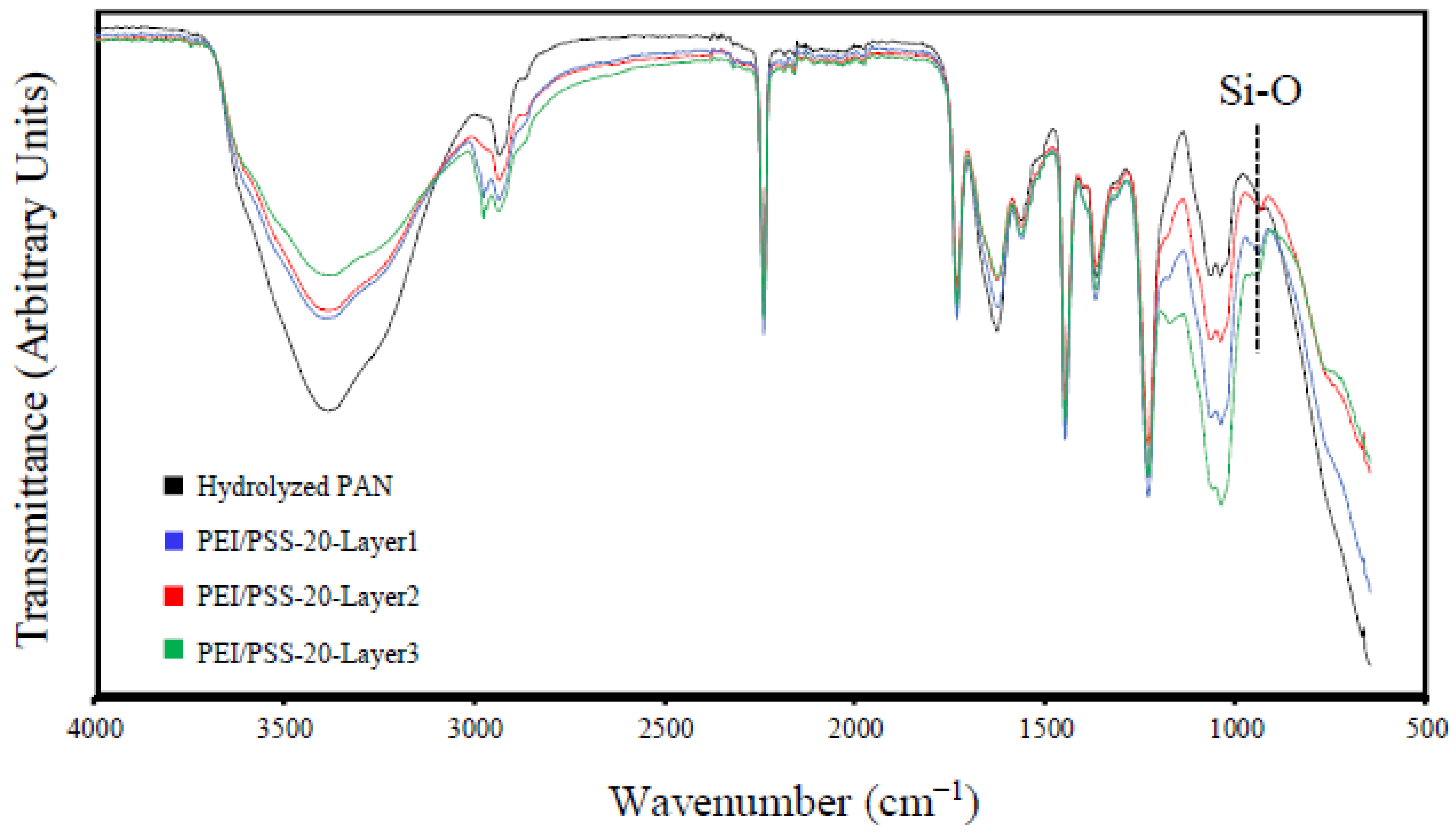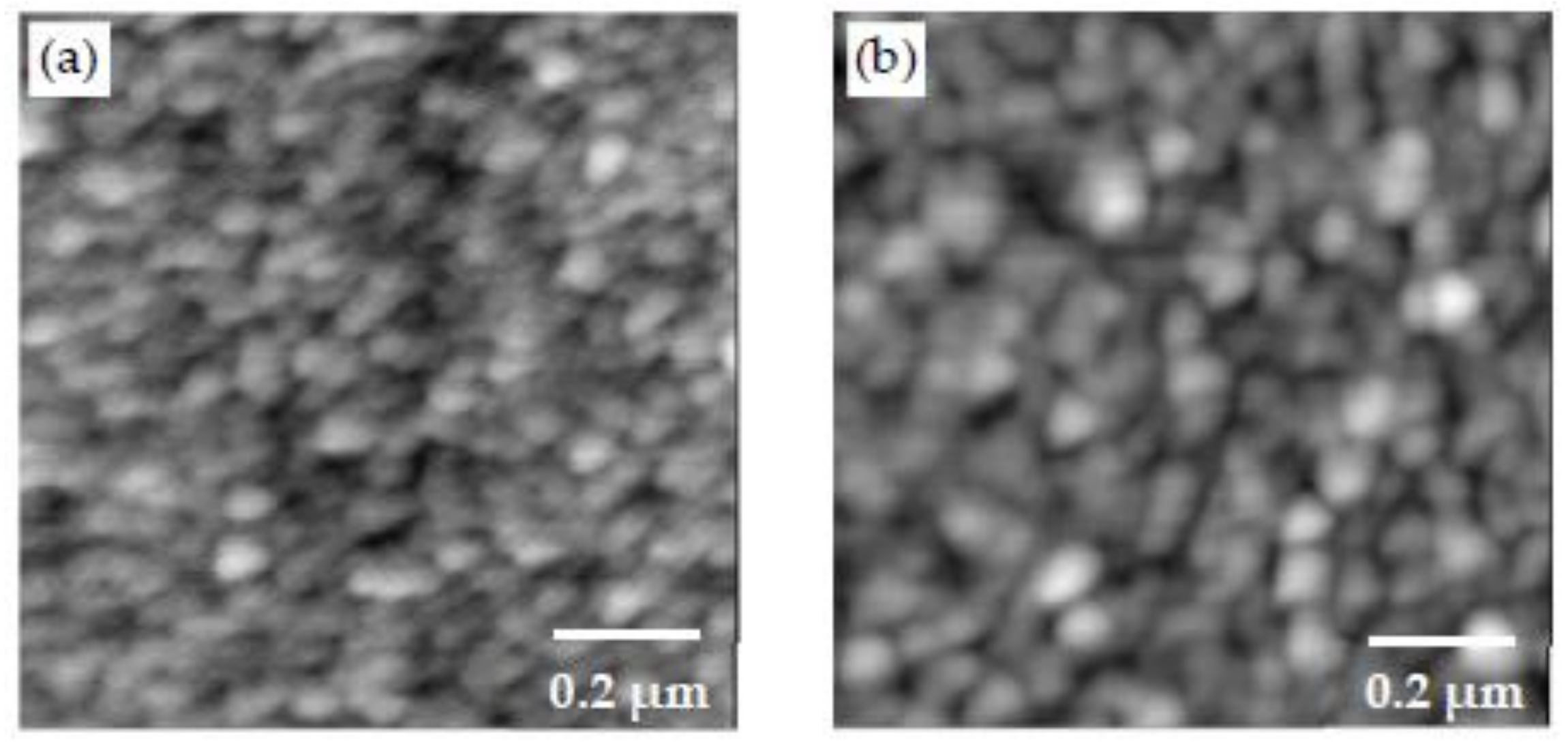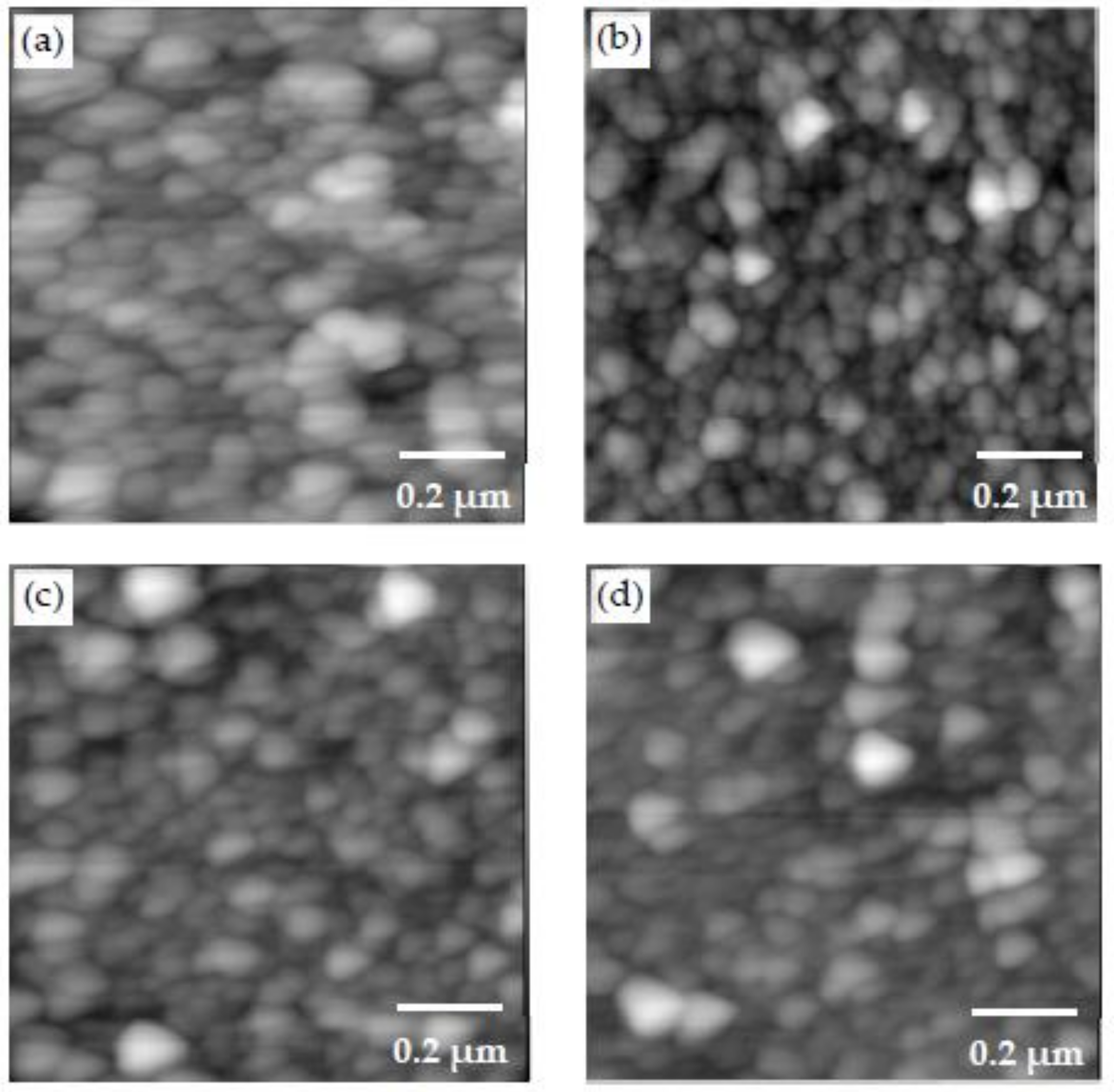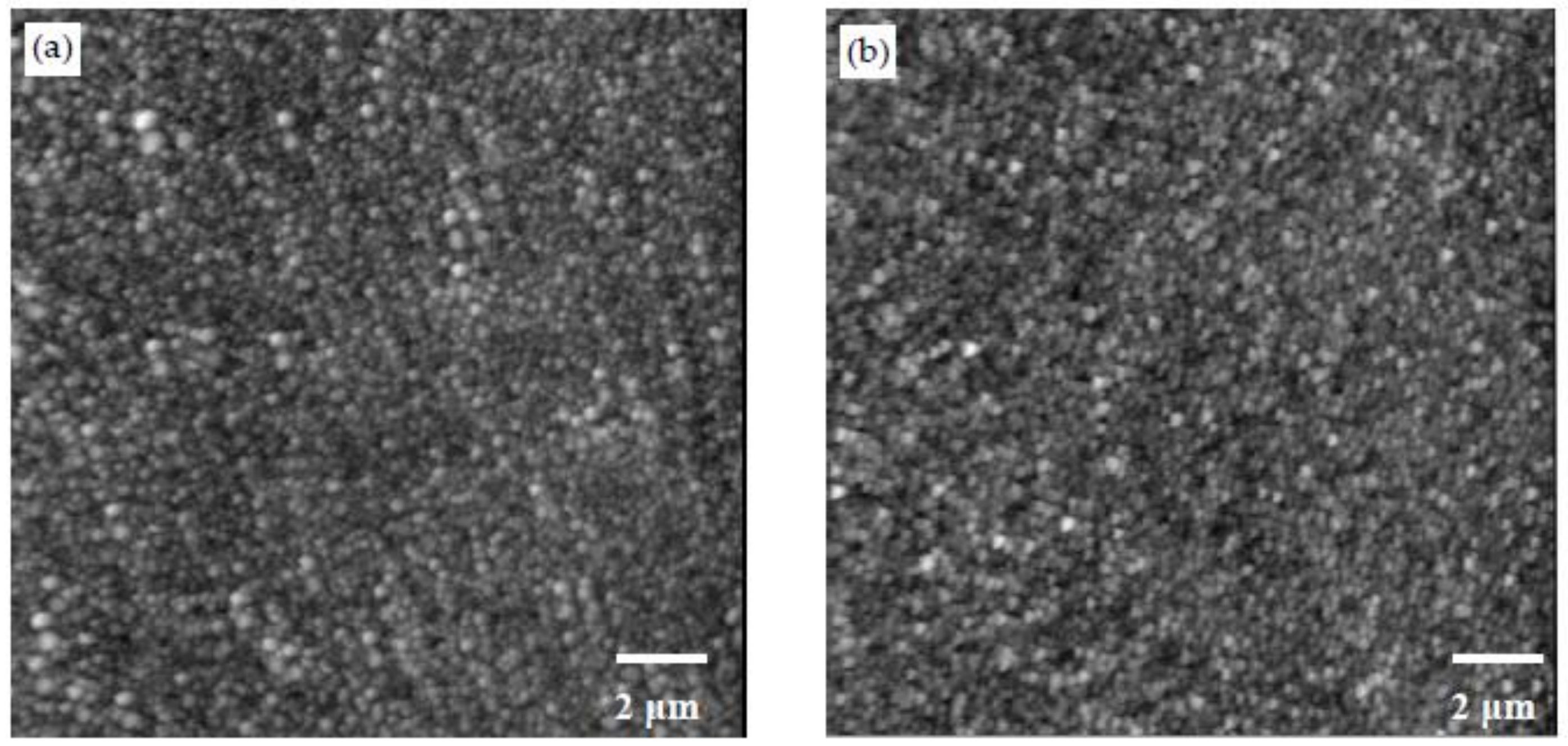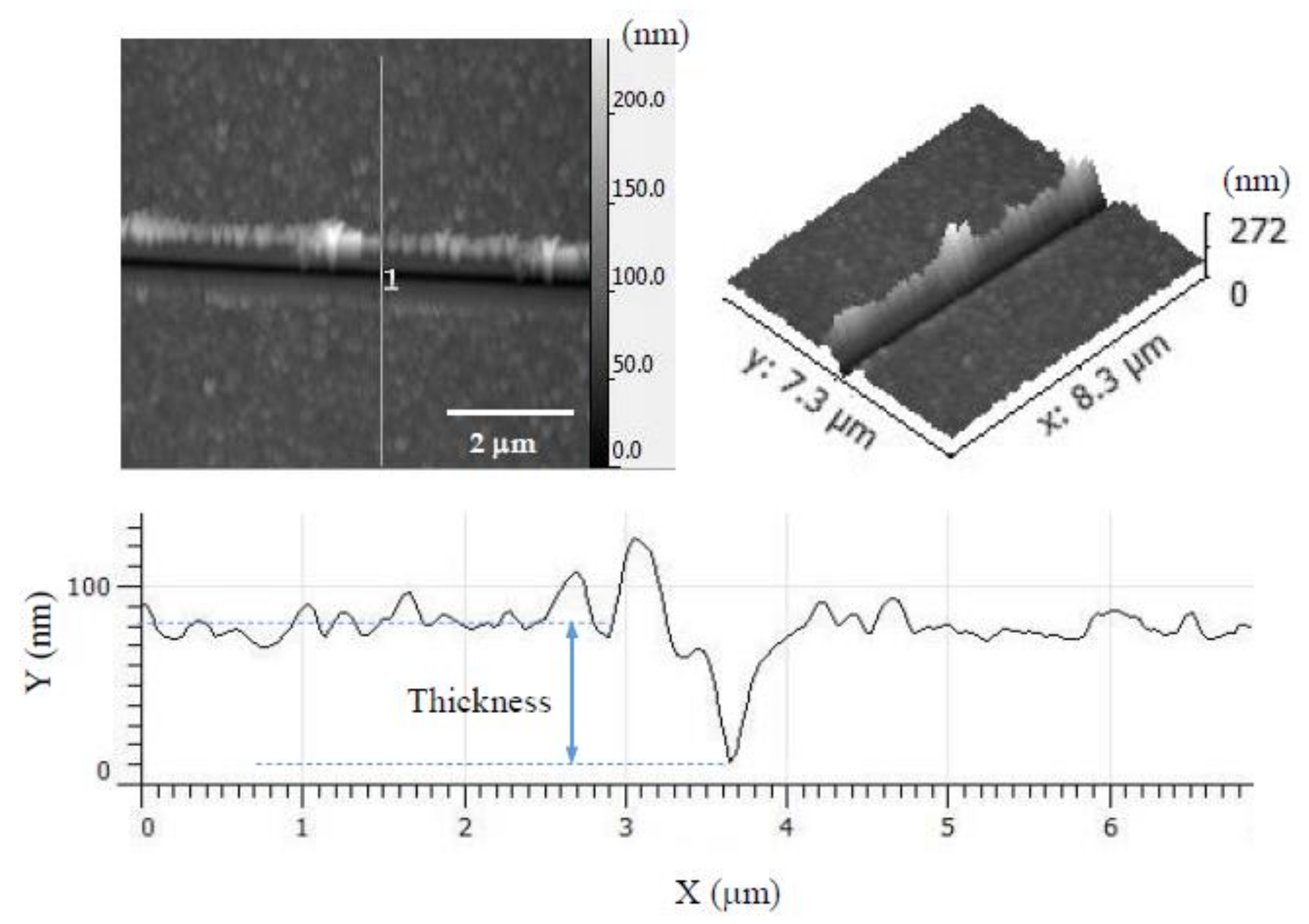3.1. Characterization
According to Guo et al. [
26], during the LBL process, calcium and silicate ions in polymer solutions react and form CSH. The CSH particles formed in each bilayer affect the morphology of the surface [
25,
26]. The formation of CSH particles during the LBL assembly was explored using XRD as shown in
Figure 3. Three bilayers of the PEI/PSS-CSH sample were deposited on a silicon wafer substrate prepared in the same way as explained for the glass slide substrate. The dipping time for each layer was 20 min. The silicon wafer was used because of its smoother surface compared to the glass slide so that the amount of noise was reduced significantly. and the thin layer of CSH was detected by XRD. The peak corresponding to CSH can be observed at 29.1° [
48] indicating the formation of CSH in the nanocomposite. It should be noted that, according to available literature, the XRD spectrum of CSH exhibits other peaks with the strongest peak typically occurring at 29.1° [
49]. Due to a very thin layer of CSH/polymer, other peaks are not evident in the XRD spectrum shown in
Figure 3.
The FTIR scans for the hydrolyzed PAN substrate and the PEI/PSS-CSH sample after deposition of each bilayer are shown in
Figure 4. The O-H band at 3390 cm
−1 and C=O band at 1632 cm
−1 in hydrolyzed PAN decreased in intensity as more layers were deposited on the sample. The C-H band of polymers at 2980 cm
−1 and the band at 1178 cm
−1 corresponding to the sulfonate moiety of PSS [
25] appeared after depositing the first bilayer and increased in intensity as the number of layers increased. The peak at 968 cm
−1 is detectable after the deposition of the second bilayer and increased in intensity by deposition of the third bilayer. This peak corresponds to the Si-O stretching band in CSH [
50] and indicates the increased formation of CSH particles as the number of bilayers increased. The peak at 1071 cm
−1 in hydrolyzed PAN is attributed to the bending vibration of C-N group [
51]. It is observed that the broad peak in the 1000–1200 cm
−1 region, which is the characteristic absorption band of Si-O-Si asymmetric stretching [
52], increased by increasing the number of layers, which provides evidence for the formation of CSH in the sample.
The results of the pH, zeta potential, and particle size measurements are provided in
Table 1. It is seen that the solution of PEI-Ca
2+ and PSS-SiO
32− has a zeta potential of 10 mV and −42.9 mV, indicating the positive and negative charge of the polymer solution after the addition of salts, respectively. By mixing the PEI-Ca
2+ and PSS-SO
32− solutions, the size of the particles was increased to 205 nm, which indicates the formation of CSH nanoparticles in the aqueous solution. The charge of PEI/PSS-CSH solution is seen to be negative and slightly lower than that of PSS- SO
32− due to the strong anionic character of PSS. The size of particles in PEI/PSS-CSH is also larger than that of PEI/PSS without Ca
2+ or SO
32−, which provides evidence for agglomeration of CSH particles in this solution. The negative charge of the particles in PEI/PSS-CSH was measured to be higher than that of PEI/PSS; this indicates the negative charge of the silicate chains in CSH formed in situ during LBL deposition.
The device was not able to measure the size of particles after mixing the PDDA-Ca2+ and PAA-SO32− solutions. This might be because of the formation of large agglomerated CSH particles. It is noted that the agglomerated particles were clearly observed in the mixed solution. The charge of particles in PDDA/PAA-CSH is also negative.
3.2. Morphology Examination
The AFM images of the PEI/PSS, PDDA/PAA and PEI/PAA samples are shown in
Figure 5a–c, respectively.
Figure 5d–f shows the AFM scans of the PEI/PSS-CSH, PDDA/PAA-CSH and PEI/PAA-CSH samples. The LBL assembly of different sets of polymers revealed different types of morphology. However, when Ca
2+ and SiO
32− ions were added to the different polymer sets, globular features were detected in all the samples. The size and roughness of these particles were different in the samples. The roughness values reported in this paper are arithmetic roughness (R
a), calculated as the arithmetic average of the surface height deviations measured from the mean plane. The roughness values of the samples over areas of 5 μm by 5 μm and 1 μm by 1 μm are shown in
Table 2. Particles in the PDDA/PAA-CSH sample were denser compared to the other samples, and the roughness value was also the smallest among the samples. This was not expected in light of the particle size analysis of the mixture of the PDDA-Ca
2+ and PAA-SO
32− solutions, as shown in
Table 1, where large agglomerates were observed. This difference could be attributed to the layer-by-layer deposition of the solutions. Particles in the PEI/PAA-CSH sample appeared larger than the other samples, which is also reflected in the increased roughness value of this sample. These observations indicate the important role of different charged polymers on the formation, growth and assembly of CSH particles. One explanation for this observation can be related to the conformation of polymer molecules in the layered structure of the samples. In PDDA/PAA-CSH, the polymer molecules may adopt a flat conformation and provide a template for growth and assembly of CSH particles. This can be attributed to the strong cationic PDDA, which maintains high positive charge density even at the pH of the solution, which is measured to be 10–11. On the other hand, PEI is a weak cationic polymer and is partially charged at the pH of the solutions, and it adopts a coil like conformation. Thus, it is expected that the growth and assembly of CSH in the coil-like template result in a larger CSH aggregate and increased porosity and less packing density of the nanocomposites, as demonstrated by increased roughness in the PEI/PSS-CSH and PEI/PAA-CSH samples. It is seen that the roughness of PEI/PSS and PEI/PAA is lower than that of PEI/PSS-CSH and PEI/PAA-CSH, respectively. It is interesting to note an opposite trend in the case of PDDA/PAA, where there is a reduction in roughness in PDDA/PAA-CSH. PAA is a weak electrolyte and is partially ionized below a pH of 6.5 [
53]. Thus, at pH = 2.9, which corresponds to the solution of PDDA/PAA, its molecular structure consists of a segmental population of loops and tails [
53]. Thus, this promotes the formation of large island-like features on the surface of the PDDA/PAA sample, which also leads to elevated roughness, as seen in
Table 2.
The AFM images of the samples prepared by different dipping times of 10 min, 20 min and 40 min are shown in
Figure 6a–c. The number in parentheses in the sample designation corresponds to the duration of dipping during the fabrication of the samples. When not included in the sample designation, it implies a dipping time of 20 min, which was used for all other samples. Gywddion [
54], an open source software to analyze the scanning probe microscopy (SPM) data, was used to apply the watershed algorithm to AFM scans in order to identify the particles and segment the images. The segmented image for one of the AFM scans is shown in
Figure 7. The number of particles, as well as their mean area were obtained using this method. The roughness values of the samples and the number and mean area of particles in the 1 μm by 1 μm scans are shown in
Table 3. By increasing the dipping time, the number of particles slightly increased, and the roughness value of the samples decreased. The increase in dipping time allowed more particles to form, and the denser morphology of the layers decreased the roughness value. A height profile (not shown here) clearly indicated that the height of the particles in the PDDA/PAA-CSH samples is much smaller than that of the PEI/PSS-CSH samples. This also explains the smaller roughness value of the PDDA/PAA-CSH samples compared to that of the PEI/PSS-CSH samples.
In order to examine the effect of pH, the PDDA/PAA-CSH-HighpH sample was prepared with the pH of the solutions raised to 12.5 by the addition of a 5 M NaOH solution. PDDA has a high positive charge density, which was reported to be unaffected by pH variation [
55]. Its resistance to pH makes PDDA a good candidate for preparing the CSH/polymer nanocomposites at high pH. The AFM images of PDDA/PAA-CSH and PDDA/PAA-CSH-HighpH are shown in
Figure 8. The roughness values of the samples and the number and mean area of particles in the 1 μm by 1 μm scan are shown in
Table 4. It is seen that the PDDA/PAA-CSH sample at high pH exhibits a higher roughness and noticeably larger particles compared to PDDA/PAA-CSH. The effect of pH increase on CSH precipitation from an aqueous solution was studied in the past and shown to influence the structure and composition of CSH [
56]. Prior work has also indicated the dependence of CSH nanoparticle aggregation on the pH of the solution [
57,
58]. The increase in pH influences the nucleation of CSH and also increases the negative charge density of CSH, which affects the interaction forces between the CSH nanoparticles and also between the CSH nanoparticles and polymer molecules. These processes are expected to be responsible for increased roughness and almost two fold larger area of the particles in PDDA/PAA-CSH-HighpH at high pH compared to PDDA/PAA-CSH. It should be noted that PAA is fully ionized above pH of 6.5 [
53] and is not expected to undergo conformational changes when pH increases from about 10–12.5, as is the case in our study. In addition, as mentioned previously, PDDA is a strong polyelectrolyte, and its charge density does not change with pH. Thus, it is unlikely that the conformational change of the polyelectrolyte contributes to the observed change in the roughness and particle area in the sample with increased pH.
The PEI/PSS-CSH samples at different C/S ratios were also studied to understand the effect of composition on the characteristics of the nanocomposites. It is well known that the C/S ratio is a determining factor in the properties of CSH [
6]. These samples were prepared varying the concentration of the sodium silicate solution to obtain C/S ratios of 0.7, 1.5 and 2.3; these samples are labelled PEI/PSS-CSH-0.7, PEI/PSS-CSH-1.5 and PEI/PSS-CSH-2.3, respectively. The AFM images of the samples with different C/S ratios are shown in
Figure 9. The image of PEI/PSS-CSH corresponding to the default C/S ratio of one is also included. The roughness values, the number, and mean area of particles in a 1 μm by 1 μm scan are shown in
Table 5. No significant differences in the morphology of the samples can be observed. One possible explanation is that the change in the concentration of the silicate ions in the PSS-silicate solution does not lead to the formation of more PSS-silicate complexes in the range of silicate concentrations used in the experiment. In this case, the formed CSH particles on the surface would have a similar chemical structure and C/S ratios regardless of the concentration of sodium silicate in the solution. The other possibility is that the samples have different C/S ratios, but the morphology of the CSH particles is not dependent on the C/S ratio in the nanocomposite studied here. It should be mentioned that morphology dependence on C/S ratio can exist in nanocomposites with other polymers, and this needs further investigations. The effect of C/S on the atomic structure and mechanical properties of synthetic pure CSH powder has been studied in the past, and C/S has been shown to influence these characteristics of CSH [
6]. However, direct morphology studies of synthetic CSH with varied C/S ratios are currently scarce. Transmission electron microscopy images of CSH powder with two different C/S were investigated in [
59] however, no comparison in regard to the difference in morphology was made between the CSH samples with different C/S ratios studied in their paper.
It should be noted that the growth mechanism, linear or non-linear, of the LBL nanocomposites is important as it determines the final properties. The growth mechanism was not examined in this paper and will be investigated in future publications.
3.3. AFM Nanoindentation
To perform nanoindentation, the PEI/PSS-CSH, PDDA/PAA-CSH and PEI/PAA-CSH samples were made by the deposition of 25 bilayers to provide a sufficient thickness for indentation. To investigate the fraction of CSH in the nanocomposites, a heat treatment at 350 °C for 3 h was performed on the samples. The polymer portion of the samples was burnt out during the heat treatment, and CSH particles were left on the substrate. It should be noted that heat treatment at this temperature can affect the properties of CSH; however, such an effect was not considered in this study. The morphology of the PEI/PAA-CSH sample before and after heat treatment is shown in
Figure 10. The roughness value of the sample before and after heat treatment was 9 nm and 8.5 nm, respectively, indicating an insignificant change in roughness as a result of heat treatment. The thickness of the deposited layers was measured before and after heat treatment. A scratch was made on the surface of the sample using the AFM probe. Then, the area around the scratch was scanned by AFM, and the thickness of the sample was measured. The AFM scan and a height profile of the scratch made on the PDDA/PAA-CSH sample after the heat treatment are shown in
Figure 11. The results of the nanoindentation and thickness measurement for the samples made with different polymer complex sets are shown in
Table 6. The thickness has decreased compared to the initial thickness in both samples after performing the heat treatment. The Young’s modulus of nanocomposites PEI/PSS-CSH and PDDA/PAA-CSH is similar and does not show a noticeable difference. The Young’s modulus of the samples before and after heat treatment is also listed in
Table 6. It is seen that the Young’s modulus of the PEI/PSS-CSH sample increased modestly after heat treatment. The increase in the Young’s modulus after removal of polymers can be explained from the composite mixing rule [
60] as the phase fraction of hard CSH is increased. However, no significant change was observed in the Young’s modulus value of the PDDA/PAA-CSH sample after performing the heat treatment. The nanoindentation of PEI/PAA-CSH also showed a small increase in the Young’s modulus after heat treatment. However, it should be noted that the roughness of PEI/PAA-CSH was large, so that reliable nanoindentation measurements of this sample were not able to be obtained, and for that reason, these values are not included in
Table 6.
The value of Young’s modulus of CSH/polymer nanocomposites after removal of polymer can be compared to those of CSH powder reported in the literature [
11,
15,
61] (see
Table 7). It should be noted that it is possible for the polymers to be incorporated in the atomic structure of CSH stacks in the form of surface adsorption or intercalation in the interlayer space [
7]. It has been shown in the literature that the removal of the polymer interacting with CSH happens at a temperature range of 250 °C–550 °C [
15]. Thus, the polymers incorporated in the atomic structure of CSH are not likely to be completely removed at the temperature used in the heat treatment. This is reflected by the lower values of the Young’s modulus of CSH after polymer removal compared to CSH powder as reported in the literature [
11,
15].
3.4. CSH/Polymer/GO Nanocomposite
As mentioned previously, LBL allows fabrication of nanocomposites with a nanoscale control over the fabrication process [
22,
23,
24,
25,
26,
27]. Thus, thin GO nanosheets are an ideal nanomaterial to study the effect of nanomaterials on CSH/polymer nanocomposites fabricated using LBL. To obtain insights into the effects of GO on CSH/polymer systems, the PEI/PSS-CSH-GO sample containing one trilayer of PEI-calcium acetate, GO and PSS-sodium silicate was prepared. The concentration of GO used in the fabrication of this sample was very low to prevent agglomeration of GO nanosheets in the nanocomposite. This way, a single GO nanosheet was able to be identified in the AFM images and allowed us to focus on the differences between the surface of GO and the surrounding regions.
The surface of the sample was scanned by AFM. The AFM scans of a GO nanosheet in the nanocomposite at different magnifications are shown in
Figure 12a–c. It is observed that the concentration of the CSH particles on the surface of the GO nanosheet appears to be higher than the surrounding areas. This can be attributed to increased nucleation sites for the formation of CSH on the surface of GO. This observation can provide evidence at the nanoscale for increased hydration in cementitious materials as a result of the addition of GO [
44]. Care should be taken in the interpretation of this observation as the effect of polymers cannot be decoupled in the LBL-fabricated CSH/polymer nanocomposite. An ideal situation would be to examine the nucleation of GO in LBL-fabricated CSH/GO systems without the presence of polymers, which seems impractical as the polymers are needed for the LBL deposition method.
The morphology of the PEI/PSS-CSH-GO samples made of 25 trilayers of GO, PEI-calcium acetate and PSS-sodium silicate is shown in
Figure 13. The concentration of GO was also higher compared to that in the sample with only one trilayer to investigate the influence of GO on the overall properties of the nanocomposite. The surface of this sample appears to be rougher and irregular compared to that of the samples without GO. The surface roughness of the sample with GO is measured to be one order of magnitude higher than that of the sample without GO. The increase in roughness could be because not all GO nanosheets are deposited in a completely planar position, and they are folded or take a wavy form within the layers, as seen in
Figure 13. The CSH particles can be observed in this figure. The folding of GO nanosheets results in a reduction in the packing density of the nanocomposite. It is worth mentioning that although GO nanosheets seem to increase the nucleation of CSH particles, the adopted morphology of GO, such as folding and waviness, could result in a loosely-packed microstructure of the nanocomposites, contributing to a lower Young’s modulus. More investigations are necessary to obtain more detailed insights into the CSH/polymer/GO systems.



